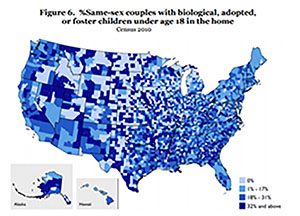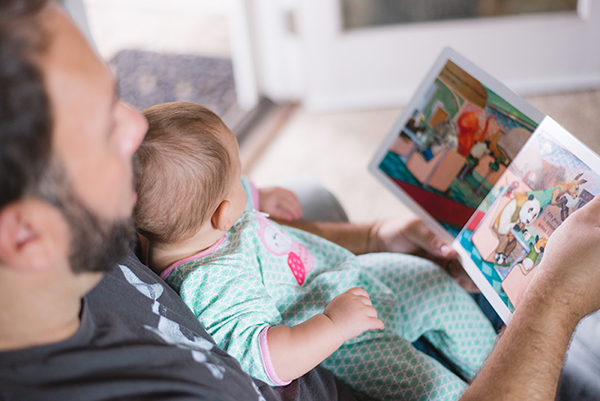LGBT Adoption and Family Law
If living in Los Angeles has one giant upside, it would have to be the diversity of cultures, people, and food. But living in our bubble makes us slightly blind to the institutional discrimination that is still widely present around the U.S. and worldwide. When you have such diversity, there are going to be groups which reside in the margins, who won’t be represented legally, because it’s hard to find individuals who are willing to dedicate their lives to work with one class distinction. At Pride Legal, it’s not about finding lawyers who only represent members of the Lesbian, Gay, Bisexual, and Transgender (LGBT) community, but about finding lawyers who understand, and care that there are different measures to take when working an LGBT case, especially those regarding LGBT adoption.
One of the major issues with same-sex marriage is the idea of consummation; many people ignorantly question how a same-sex couple ensures the continuation of the human race? Well, the simple fact is that in 2014 roughly 400,000 children in the US alone were in the foster care system, and only a fourth had the chance to be adopted. The human population is not having any problems thriving; it is having issues with nurturing its youth. These children need homes, regardless of the adoptive parent’s sexual orientation. What judges a good parent should be a legal precedent, not an antiquated tradition.
As an interim, adoption, foster care, and legal guardianship are a means to support children who are in need of homes to eat, sleep, and grow up. In California, more than 16,000 children are adopted by lesbian, gay, bisexual, or transgender adults, and that number is growing each year.
Up until recently, almost a third of adoption agencies had the right to decline LGBT adults from adopting a child based on religious affiliation or state law. For many, LGBT adoption is a new concept because it blurs the concept of the “nuclear family” – mom, dad, two kids, and a dog.
In light of progress towards more equal institutions, programs coming from the Millennium Development Goals, and UNICEF are helping children in the foster care system, but the orphan rate is still at an all time high. Furthermore, when a single adult, LGBT or not, applies for adoption, they may be suspect for greater evaluation to ensure their capability to raise a child.
Proving an individual is capable of raising a child is necessary in all cases, making an extra effort to ensure a person cannot raise a child is a form of discrimination.
Although the facts are out there and the programs are in place, many Americans have no idea how adoption works, let alone how LGBT adoption differs. We, at Pride Legal, decided it was about time to create a piece that reflected the process of LGBT adoption, from incany to maturation.
Download the FREE Pride Legal LGBT Adoption e-book here.
1. Differences in Adoption
Although there are three methods to adoption, the child may not be the deciding voice. Birth parents may decide to place their child for adoption, where an agency will assume responsibility and care for the child’s future family ties. A child may also be placed into foster care if child a welfare worker determines the child is unsafe due to abuse or neglect.
The three different forms of guardianship are listed below:
Foster Care: This system places the children/minors into a group home, or private home with a state certified caregiver, “foster parents”. The group homes, and caretakers must undergo regular evaluation by child welfare workers to maintain care for the child. Often, it is encouraged for the foster parents to adopt the child, after the court orders an adoption plan.
Adoption: This is the permanent process to assume care for a child. Adoption requires transferring all rights and responsibilities from the biological parents, to the adoptive parents.
In an open adoption, biological parents may have a degree of communication and interaction in the child’s life. In 2009, the U.S. allowed legally enforceable open adoption contract agreements to be included in the adoption process.
In a closed adoption, there are seals protecting information to prevent disclosure of adoptive parents’ and biological parents. A closed adoption will allow for “non-identifying” information to be released – medical records of child, and ethnic background.
Regardless of the type of adoption, both will undergo regular evaluations by child welfare workers and government officials.
Legal Guardianship: In simple terms, a legal guardian is a person who has the legal authority to care for the personal interests of another person and their property. A parent can designate a legal guardian in the case of death, albeit this must be approved by the court.
2. After Adoption
In all three cases, there is an evaluation, follow up, and general checkups conducted by the state or child welfare workers to confirm that the child is in a suitable living situation.
Foster Care: As a foster parent, your job is to ensure the child is taken care of regarding education, room, and board. During their stay in a foster care home, an agency overseeing the child’s case makes more immediate care decisions, such as educational and religious decisions. Unless another legal guardian or biological parents in given authority, the agency and child welfare workers have this designated role until the child is 18-21, or the child achieves permanency through adoption or legal guardianship.
Adoption: Adoptive parents have the authority to govern the adopted child’s life. They have an identical responsibility to birth parents. When parents adopt through foster care, they receive monetary assistance via adoption assistance programs and Medicaid. These benefits do not exist in a private domestic or international adoption.
- ICPC – If your adoption takes place across the nation; you must remain within your state lines until the Interstate Compact for the Placement of Children paperwork is finalized (two weeks at most).
- Post Placement Visits – after adoption, a home study provider will visit you and your new family to ensure that everyone is adjusting well to the new situation.
- Finalization Hearing – after the first two steps, a judge will review and declare the finalization of the adoption.
Legal Guardianship: Unlike adoption, a legal guardianship will remain overseen by the court till the child is of legal age. This includes a yearly status report made by the guardian to the court, as well as meeting with court investigators and social workers as deemed necessary by the court. A court can also impose any requirements for a child which might be in need.
3. Domestic Adoption in California
For same-sex couples to adopt a child together, they may need to receive a permit for joint-adoption. After the constitutional legality of same-sex marriage in the US, it also became illegal to halt the adoption of a child based on the sexual orientation of the adoptive parent.
Discrimination still occurs based on religious affiliation, however, in California, this happens less and less each year. There are two varying styles of adoption, domestic – within the same country, and international.
When dealing with domestic adoption, the process can either be independent or through an agency.
Independent: Often arranged by a family law attorney, or an adoption agency, requires a birth mother to consent or choose the adoptive parents. Because 85% of adoptions are independent, the birth mother is often in control of choosing the adoptive parent. Therefore, it is recommended that you meet with the birth mother and-or make a good case for why you are the right choice for a parent. Getting an adoption lawyer is the smoothest way to approach these issues.
For better understanding on the “foster to adopt” process we reached out to Extraordinary Families, a foster care and adoption agency based in Los Angeles.
Foster to Adopt: Foster family and County agencies find homes for children who have already entered the foster care system. These children range in age from 0-18. If the court determines the children are not able to return to their biological parents, a plan for adoption is made. There is a high percentage of older children, 5+ years, in need of adoptive parents. Although in the hands of the state, an adoptive attorney will help settle any questions or concerns about adopting through foster care.
4. Statistics Behind LGBT Family Adoption
According to a canonized essay by Gary J. Gates, LGBT Parenting in the United States, same-sex couples are “four times more likely than their different-sex counterparts to be raising an adopted child,” and “six times more likely than their different-sex counterparts to be raising foster children.” These numbers are rising each year as more and more same-sex couples are getting married.
 Over the years, the facts of children living with LGBT parents has risen tremendously. As the trend continues, that number will only increase, as same sex adoption and parenting becomes more and more widely accepted.
Over the years, the facts of children living with LGBT parents has risen tremendously. As the trend continues, that number will only increase, as same sex adoption and parenting becomes more and more widely accepted.
Today, more and more LGBT parents have taken action by retaining a family lawyer, and LGBT lawyers who are both knowledgeable and passionate about breaking down the barriers restricting adoption for LGBT couples.
5. LGBT Cultural Competency Laws
In 2012, California Governor Jerry Brown signed a bill requiring foster parents and other caregivers to undergo training in “cultural competency and sensitivity” regarding lesbian, gay, bisexual and transgender youth. If all that is required is a single 60-minute session once a year, there is no in depth curriculum, however, there is at least an attempt made to bring light to LGBT issues within the adoption process.
Three other states, including Illinois, Nevada, and Utah, have enacted similar laws. These state laws or state agency regulations require current and prospective foster parents to get proper training about cultural understanding behind the LGBT youth and the legal requirements. These laws and regulations are designed to improve the safety and outcomes for LGBT youth in the child welfare system.
The District of Columbia along with 46 other states, do not require LGBT cultural competency training.
Reasons behind competency laws seem to come from love. However, they may be slightly misguided. There is so much separation and inclusion regarding LGBT individuals and families that it is impossible to even gain a surface level understanding within one 60 minute competency session. There are many surprises to LGBT adoption facts.
6. Disproportionately High Percentage of LGBT Youth
According to a UCLA study conducted in 2014, More than 400,000 children in America are in foster care, and among them, there’s a disproportionate number of LGBT kids. In Los Angeles County, about 1 in 5, or 1,400 foster youth, identify as LGBT. Los Angeles County is home to the nation’s largest population of foster youth.
If the trend remains, that an LGBT child is unwelcome in the home, then that child may run away or get thrown out by their parents. Because many foster parents are not given the correct training to understand the LGBT community, they might not be completely at fault when it comes to mishandling the child’s sexual identity. These disagreements and misunderstandings between parent and child lead to stress, conflict, and distrust. A child who has already been through the ringer that is the foster care system might be out of hope or enthusiasm for adoptive parents who are not fully accepting of their child’s sexual orientation.
The harsh realities of the disproportionately high percentage of LGBT youth are that over 40% are homeless. Family rejection and abuse are a huge factor contributing to LGBT youth homelessness. “America’s next generation of gay and transgender youth need us to stand with them so that they can stand on their own”, Gregory Lewis, executive director of Cyndi Lauper’s True Colors Fund, words the challenges of LGBT youth poetically. He goes on to say, “in order for this to happen we all need to join together and support the hardworking and dedicated service providers helping these young people every day, we need to redouble our efforts to support them so they can help all of the youth in need”.
Support comes in many forms, but the lack of funding for homeless youth providers is beginning to negatively impact the possibility of improvement. On top of everything these kids are facing, they also deal with blame; feeling as though being LGBT is wrong, and that somehow they deserve to be abused as a result.
Leaving home sometimes seems like a shot for freedom for these kids, but their lives are instantly in danger once they lose the safety of a home. Christopher Rodriguez, a Florida resident, ran away from home when he was 17, fearing his father’s response to his sexuality. He felt that this escape was his only way to grasp freedom until he realized, “The only thing you’re thinking about is what am I going to do now? Because I have no roof to sleep under. I was in fear for my life”.
Although many children leave home on their own, like Rodriguez, all over the country, families are asking children to leave – taking away the option to return home. However, even the programs set up to help these children can sometimes be the cause of abuse.
Creating a safe place for kids, regardless of sexual orientation, should be top priority when it comes to government provided programs. Creating awareness and being honest with ourselves as a nation about the problems of the growing rate of LGBT youth is key in developing programs and gaining funding.
7. Children of LGBT Parents
In 2004, the American Psychological Association stated that “the development, adjustment, and well-being of children with lesbian and gay parents do not differ markedly from that of children with heterosexual parents.” The arguments should have halted here, with more scientific and psychological data to back up their claim.
The claims made by the opposition are that the children of LGBT parents will potentially experience more difficulty in their own sexual identity than those with heterosexual parents. Even though, the opposite is true; children who come from same-sex parents have a harder time connecting with or understanding same-sex relationships, therefore might have more difficulty understanding their own sexual orientation if they feel at all different from their parents.
Another claim against LGBT individuals becoming adoptive parents is that the child will undergo a form of marginalization or bullying due to their new parent’s sexual orientation. However, it should be noted that this claim equates LGBT to a form of social disability or handicap, which is an absurd idea considering there are over six million American’s with LGBT parents.
For more information, we reached out to FamilyTime Centers, a neurotherapy and psychotherapy center based in Los Angeles.
On LGBT Counseling: LGBT counseling is so important when considering the “normal” stress you deal with everyday is heightened by the stress of being a marginalized group who deals with societal backlash. We believe in alternative therapy for mental health, not medication, you do not need to medicate LGBT individuals, because it is not a mental illness, or a burden. However, the prejudice and discrimination LGBT members face on a daily basis is enough to cause mental health concerns.
There has never been proof of any kind to back up the prejudice claims of social scientists attempting to push back the LGBT community. In fact, research has shown that children with LGBT parents develop similar to those with heterosexual parents. Some studies may be more inconclusive and underdeveloped because it has only been about two years since the official legalization of gay marriage throughout the united states. Nonetheless, all the social science up to date is showing positive and healthy results for children adopted into LGBT families, if anything the results are sexual orientation has no change on the upbringing of a child.
A subsequent policy statement was made by the American Academy of Child & Adolescent Psychiatry in 2009. “All decisions relating to custody and parental rights should rest on the interest of the child. There is no evidence to suggest or support that parents who are lesbian, gay, bisexual, or transgender are per se superior or inferior from or deficient in parenting skills, child-centered concerns, and parent-child attachments when compared with heterosexual parents. There is no credible evidence that shows that a parent’s sexual orientation or gender identity will adversely affect the development of the child.”
8. LGBT Parents Nurture Tolerance
Tolerance for others often comes from individuals who have the ability to sympathize and empathize with others. It would not be a stretch to say that, Americans who have experienced some sort of pain, are thus able to identify with the pain of others. This theory has gained much popularity in the social sciences, as more and more psychiatrists are finding that children raised by LGBT parents are taught to be more open minded, and empathetic towards other humans and animals.
Abbie Goldberg, a clinical psychologist at Clark University in Massachusetts, published a study on gay and lesbian parents in 2007. She found that 28 out of 46 adults who had an LGBT parents felt more empathy than adults who were raised in opposite sex households. Goldberg went on to say, “These individuals feel like their perspectives on family, on gender, on sexuality have largely been enhanced by growing up with gay parents.”
LGBT parents leave their children feeling slightly more nurtured to handle discrimination being opened up to difference from the start.
9. Cooperation Matters More Than Sexual Orientation
This year, Rachel H. Farr, a Gender and Women’s Studies, and Psychology professor at the University of Kentucky focused on LGBT adoption in her essay, Does Parental Sexual Orientation Matter? Farr contends that “children’s healthy development depends upon healthy family functioning more so than family structure.”
The essay goes on to conclude that “children’s behavioral problems and family functioning during middle childhood were predicted by earlier child adjustment issues and parenting stress” again, not their sexual orientation.
Cooperation matters more than sexual orientation! In Los Angles, we have the privilege of living in a fast-paced and open minded city which values creativity over sexual orientation. Being part of a marginalized group can sometimes make people feel alienated, however, it builds a community. Having this community is so valuable during times of need, confusion, and therapy. Every single lawyer working with Pride Legal, is either a member of the LGBT community, or closely works within in. Do not overlook the value of this connection with considering adoption as an LGBT parent because you need someone who understands the difficulty of following rigid laws, by your side.
10. The future of LGBT Family Law
In truth, we need these types of longitudinal studies that trace a child’s upbringing because the laws regarding LGBT families have all changes in the last two years. Previous research is now outdated since its legal precedents differ. Therefore, new research is necessary to change the way we react and approach LGBT families, and adoption. New studies on LGBT adoption needs to include the voices of the children, their feelings and their opinions on how they are and were raised. The parents are important, but if the prejudice claims made are that LGBT parents are unfit to raise children then, the children are the ones who can prove this wrong.
Download the FREE Pride Legal LGBT Adoption e-book here.
For more information on who to go through the adoption process with as a member of the LGBT community, contact a lawyer through Pride Legal, which specialized in connecting clients with qualified attorneys experienced in representing the LGBT community throughout California.






